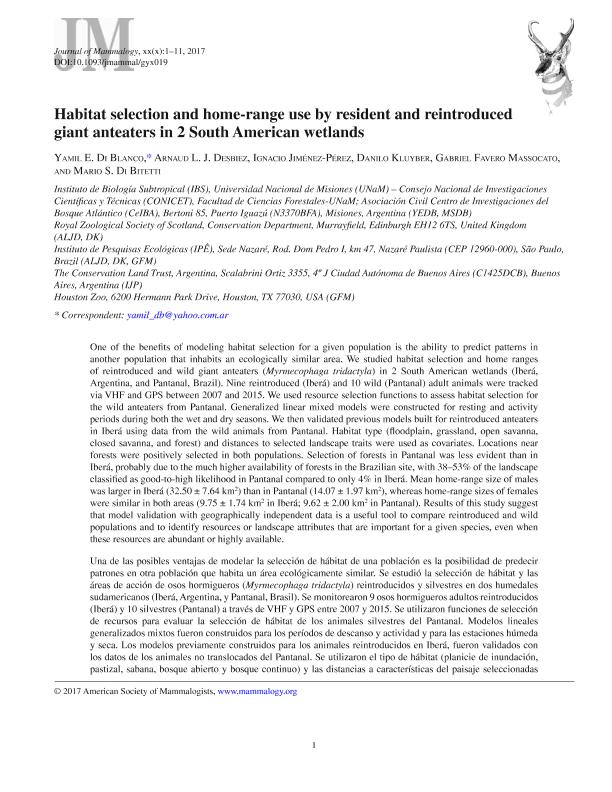Mostrar el registro sencillo del ítem
dc.contributor.author
Di Blanco, Yamil Edgardo

dc.contributor.author
Desbiez, Arnaud L. J.
dc.contributor.author
Jiménez Pérez, Ignacio
dc.contributor.author
Kluyber, Danilo
dc.contributor.author
Favero Massocato, Gabriel
dc.contributor.author
Di Bitetti, Mario Santiago

dc.date.available
2018-10-30T17:55:13Z
dc.date.issued
2017-02
dc.identifier.citation
Di Blanco, Yamil Edgardo; Desbiez, Arnaud L. J.; Jiménez Pérez, Ignacio; Kluyber, Danilo; Favero Massocato, Gabriel; et al.; Habitat selection and home range use by resident and reintroduced giant anteaters in two South American wetlands; Oxford University Press; Journal of Mammalogy; 98; 4; 2-2017; 1118–1128
dc.identifier.issn
0022-2372
dc.identifier.uri
http://hdl.handle.net/11336/63313
dc.description.abstract
One of the benefits of modeling habitat selection for a given population is the ability to predict patterns in another population that inhabits an ecologically similar area. We studied habitat selection and home ranges of reintroduced and wild giant anteaters (Myrmecophaga tridactyla) in 2 South American wetlands (Iberá, Argentina, and Pantanal, Brazil). Nine reintroduced (Iberá) and 10 wild (Pantanal) adult animals were tracked via VHF and GPS between 2007 and 2015. We used resource selection functions to assess habitat selection for the wild anteaters from Pantanal. Generalized lineal mixed models were constructed for resting and activity periods during both the wet and dry seasons. We then validated previous models built for reintroduced anteaters in Iberá using data from the wild animals from Pantanal. Habitat type (floodplain, grassland, open savanna, closed savanna, and forest) and distances to selected landscape traits were used as covariates. Locations near forests were positively selected in both populations. Selection of forests in Pantanal was less evident than in Iberá, probably due to the much higher availability of forests in the Brazilian site, with 38?53% of the landscape classified as good-to-high likelihood in Pantanal compared to only 4% in Iberá. Mean home range size of males was larger in Iberá (32.50 ± 7.64 km2) than in Pantanal (14.07 ± 1.97 km2), whereas home range sizes of females were similar in both areas (9.75 ± 1.74 km2 in Iberá; 9.62 ± 2.00 km2 in Pantanal). Results of this study suggest that model validation with geographically independent data is a useful tool to compare reintroduced and wild populations and to identify resources or landscape attributes that are important for a given species, even when these resources are abundant or highly available.
dc.format
application/pdf
dc.language.iso
eng
dc.publisher
Oxford University Press

dc.rights
info:eu-repo/semantics/openAccess
dc.rights.uri
https://creativecommons.org/licenses/by-nc-sa/2.5/ar/
dc.subject
Forest
dc.subject
Habitat Use
dc.subject
Model Validation
dc.subject
Myrmecophaga Tridactyla
dc.subject
Resource Availability
dc.subject
Resource Selection Functions
dc.subject.classification
Otras Ciencias Biológicas

dc.subject.classification
Ciencias Biológicas

dc.subject.classification
CIENCIAS NATURALES Y EXACTAS

dc.title
Habitat selection and home range use by resident and reintroduced giant anteaters in two South American wetlands
dc.type
info:eu-repo/semantics/article
dc.type
info:ar-repo/semantics/artículo
dc.type
info:eu-repo/semantics/publishedVersion
dc.date.updated
2018-10-29T17:02:31Z
dc.journal.volume
98
dc.journal.number
4
dc.journal.pagination
1118–1128
dc.journal.pais
Reino Unido

dc.journal.ciudad
Oxford
dc.description.fil
Fil: Di Blanco, Yamil Edgardo. Centro de Investigaciones del Bosque Atlántico; Argentina. Consejo Nacional de Investigaciones Científicas y Técnicas. Centro Científico Tecnológico Conicet - Nordeste. Instituto de Biología Subtropical. Instituto de Biología Subtropical - Nodo Puerto Iguazú | Universidad Nacional de Misiones. Instituto de Biología Subtropical. Instituto de Biología Subtropical - Nodo Puerto Iguazú; Argentina
dc.description.fil
Fil: Desbiez, Arnaud L. J.. Royal Zoological Society Of Scotland; Reino Unido. Instituto de Pesquisas Ecológicas; Brasil
dc.description.fil
Fil: Jiménez Pérez, Ignacio. The Conservation Land Trust; Estados Unidos
dc.description.fil
Fil: Kluyber, Danilo. Instituto de Pesquisas Ecológicas; Brasil. Royal Zoological Society Of Scotland; Reino Unido
dc.description.fil
Fil: Favero Massocato, Gabriel. Instituto de Pesquisas Ecológicas; Brasil. Houston Zoo; Estados Unidos
dc.description.fil
Fil: Di Bitetti, Mario Santiago. Consejo Nacional de Investigaciones Científicas y Técnicas. Centro Científico Tecnológico Conicet - Nordeste. Instituto de Biología Subtropical. Universidad Nacional de Misiones. Instituto de Biología Subtropical; Argentina. Centro de Investigaciones del Bosque Atlántico; Argentina
dc.journal.title
Journal of Mammalogy

dc.relation.alternativeid
info:eu-repo/semantics/altIdentifier/doi/http://dx.doi.org/10.1093/jmammal/gyx019
dc.relation.alternativeid
info:eu-repo/semantics/altIdentifier/url/https://academic.oup.com/jmammal/article/98/4/1118/3070678
Archivos asociados
